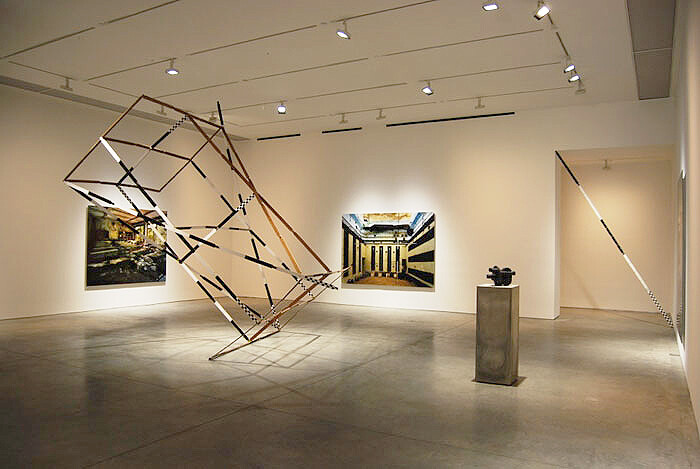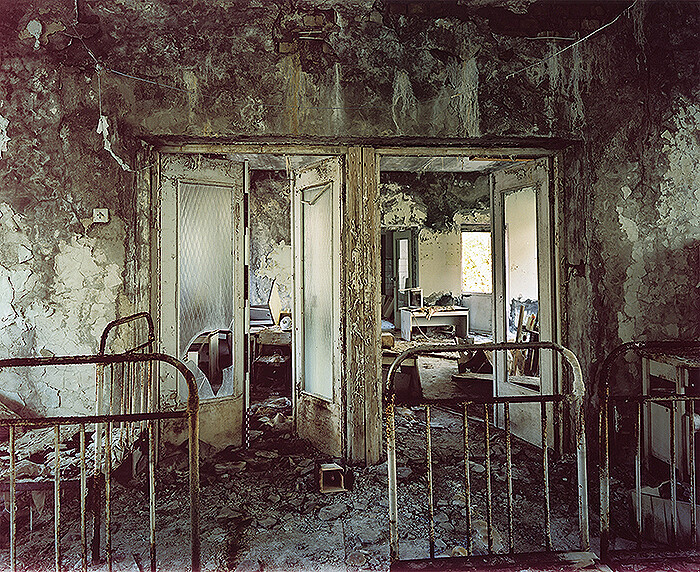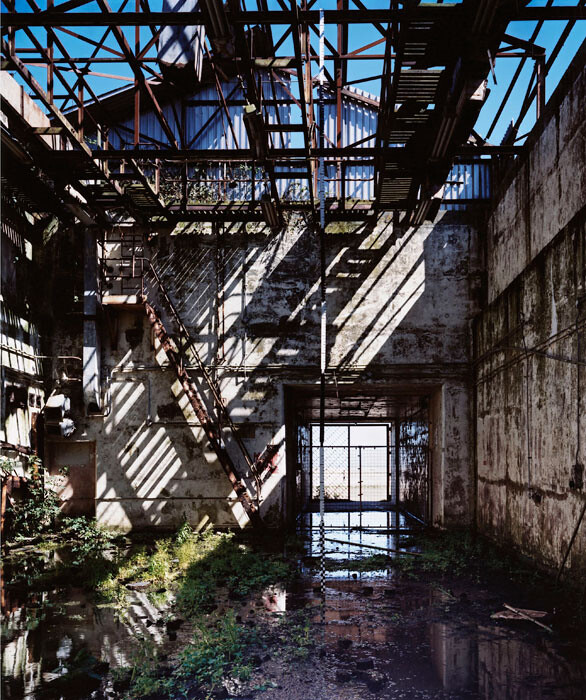For over two decades, British artists (and sisters) Jane and Louise Wilson have meticulously documented the architectural ruins of twentieth-century modernity. In specific, their focus has been directed towards the dire fate of obsolete military-industrial constellations. Like many artists coming of age after the collapse of the Soviet bloc, their work seems irresistibly drawn to the decaying skeletons of modernist utopias. They sift through debris to uncover present-day resonances that also happen to produce eerily beautiful photographs, films, and installations. Their current exhibition at 303 Gallery shows that the subject still holds their attention while making a compelling case that it should also hold ours.
The works on view are culled from two recent projects, and their undifferentiated installation in one gallery emphasizes an ongoing engagement with the history of Cold War nuclear ambitions and socialist utopianism. The recurring motif here is the yardstick—discreetly included in each of the seven large photographs on view, and reappearing as actual yardsticks in the gallery: some reaching from floor to ceiling in a corner, others stretching diagonally across a doorway, and finally as a large geometric sculpture in the center of the room.
One set of photographs is from the series “Atomgrad, Nature Abhors a Vacuum” (2010–12), which shows scenes of Pripyat, in present-day Ukraine, a Soviet city built in the late 1970s to house the workers at the nearby Chernobyl nuclear facility. The city was evacuated two days after the explosion of the power plant in 1986 and has stood abandoned since. The Wilsons’ photographs, which focus on public buildings (schools, hospitals, and amphitheaters), convey a manmade landscape in the process of being gloriously reclaimed by nature, windows broken, floorboards strewn about, everything rusted, dusty—and highly photogenic. The Atomgrad photographs convey the same approach, in their spectacular rehearsal of post-industrial sublime, as the second series on view: “Blind Landing, H-Bomb Test Facility” documents a site-specific installation the Wilsons produced in 2012 at the former British nuclear testing labs on the island of Orford Ness, off the Suffolk coast, where they planted yardsticks in the peeled and rusting buildings once used to analyze radioactive material.
Despite the Wilsons’ reticent documentary style, the photographs have a distinctive painterly palette. Broken and decaying modernist grids are portrayed as lush gradations of golden light, warm rust, and cool shadow, their lack of human presence all the more pronounced for being public architecture. The images could be understood as memento moris, the still life tradition of decaying bowls of fruit and flowers that admonished good Christians to “remember that you will die.” But the effect is hardly imperious. Their form of address is collective and political rather than theological, and in our current moment of overweening nuclear ambitions, ever-increasing environmental disasters, and persistent amnesia about the events and prehistories that brought us here, we would do well to heed the invitation to reexamine these pasts.
The sculptures complicate the overall message. Hanging in the middle of the gallery, the wooden yardsticks of Altogether (2010) are less like the radical Constructivist sculpture that inspired it, and more like a sagging, makeshift maquette that turns the idea of measurement back on itself, like a Mobius strip. The yardsticks, hidden away in every image as if an anthropological photograph had been playfully rearranged, imply “scientific” accuracy and scale without actually delivering. Instead, it is the architecture that most tangibly records the passing of time and the chaotic effects of nature. The “imperial measure” of the yardstick, like the empire itself, is just another obsolete system. The yardsticks are most effective in countering the stark emptiness of the photographs, making the viewer aware of the artists’ intervention and bringing us back, full circle, to our own potential relationship to images and objects, and difficulties of resolving the ideological questions they raise.
For all of its political implications, the Wilsons’ is ultimately an aesthetic project of cautionary tales, where historic narrative is the medium rather than the goal. Their photographs give a concrete—and spectacular—materiality to distant and intangible disasters like Chernobyl, even as the actual sites are fading back to their prior state. If the images succeed in holding our attention, it is because of their skillful combination of visual impact and nostalgic identification. Their political position, neither homage nor critique proper, prioritizes looking above all else, using the tools of its artistic arsenal to facilitate a slow and reflective examination of the texture of modernist decay. And this is precisely the work’s success: approaching history from an oblique angle, their camera captures not only sites in transition, but the potential inherent in historic material that continues to pose difficult ideological questions.







